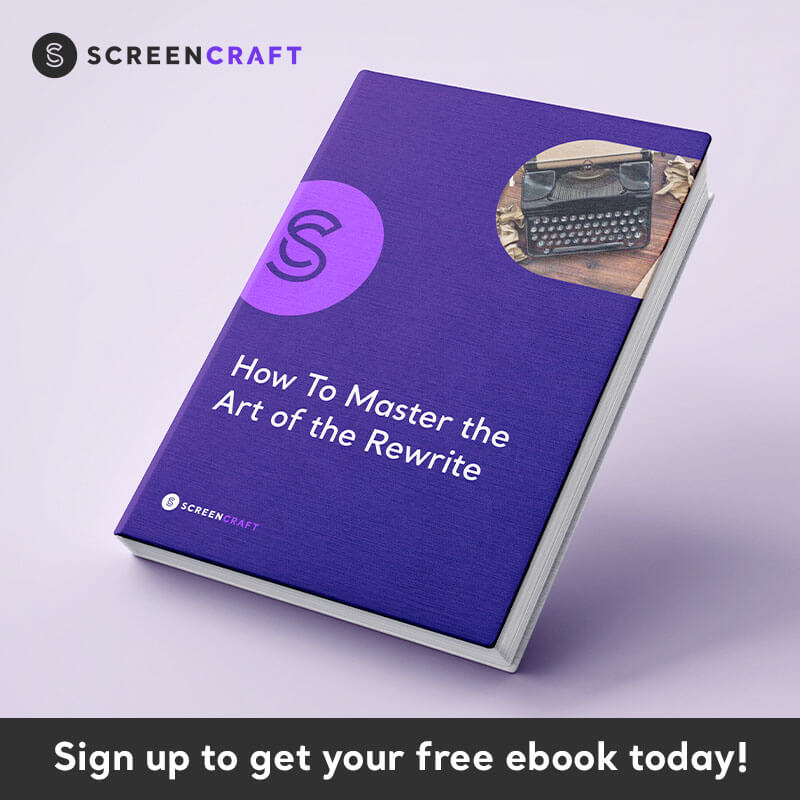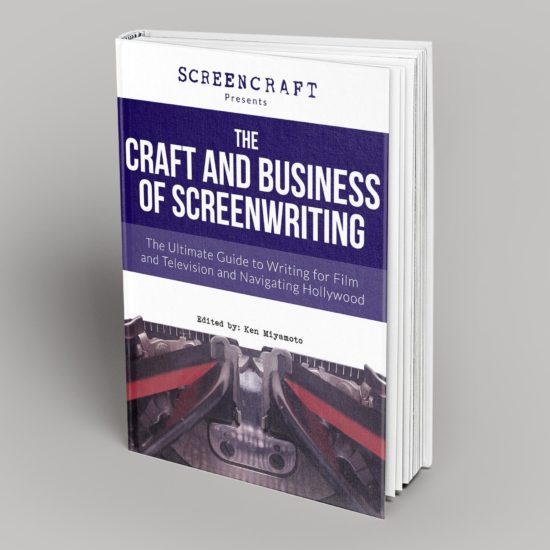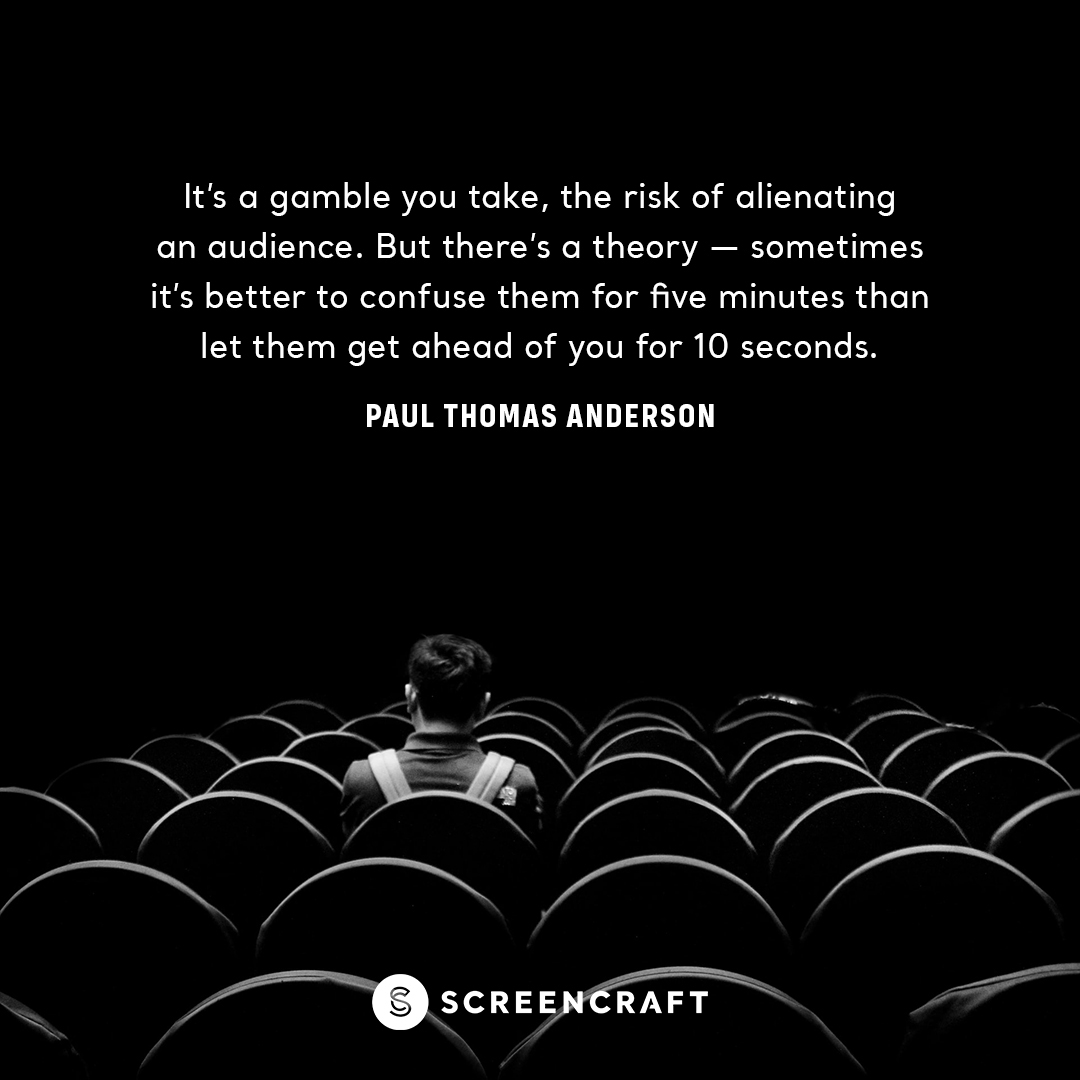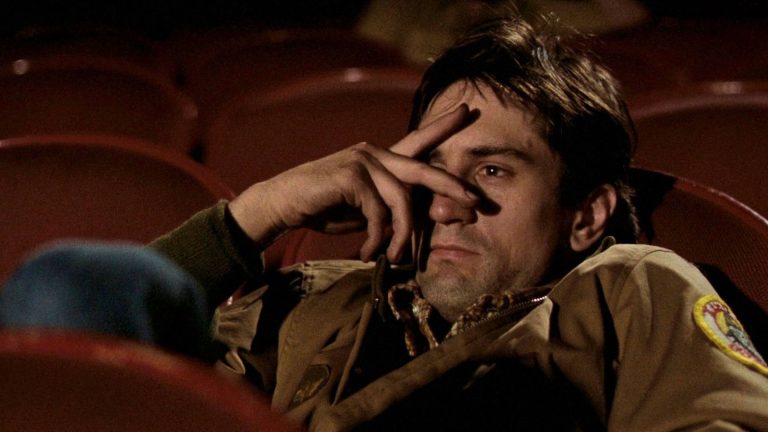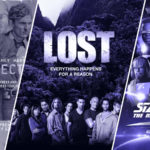
What if we told you that there are more ways for screenwriters to get noticed than through normal submission processes via email, through representation, and from high placements in screenwriting contests, competitions, and fellowships?
While those are solid portals into the industry, there are many other ways that screenwriters continue to break through — leading to big breaks and successful careers. In order to find those creative ways, you have to push your thinking up to and beyond its limit. You have to truly think out of the box.
Here are five ways to enhance your out-of-the-box thinking as it applies to your hopes and dreams of a successful screenwriting career.
1. Use Your Screenplay as a Book Proposal
Hollywood and the publishing industry have been more intertwined than they ever have been. Publishing houses look for projects that will also bring in Hollywood adaptation money and book publicity. Hollywood goes to the literary best seller lists and beyond to find their next big movies to produce.
Screenwriters need to start thinking outside of the box when it comes to the platforms they can use to get noticed. Because Hollywood is still so risk averse, screenwriters have fewer and fewer opportunities to break through by going the normal submission route — submitting directly to agencies, managers, and studios, entering contests and fellowships, etc. While those routes are still viable ways in, you need to also go extra mile.
What if you could use your screenplay as part of a book proposal to submit to publishing firms?
While writing a book is much different than having written a screenplay — Read ScreenCraft's Should You Be a Novelist or Screenwriter? for more on that — you, again, need to think in a more broad fashion to increase your odds of being at the right place, at the right time, with the right story.
Book proposals generally consist of an introduction, book outline, and sample chapter. The book outline breaks down the chapters within a proposed book. If you're considering trying to tell your cinematic stories in literary form, you can use your screenplays in place or along with such outlines, offering publishers a clear beginning, middle, and end to the story that you want to tell.
Dances with Wolves was a screenplay first, as was Cormac McCarthy's No Country for Old Men. If Hollywood isn't responding to your story, and you truly believe that it is a story that should be told, look elsewhere. Think beyond standard practices. And remember that in the end, publishers and studios are all in the same boat now.
2. Choose a Unique Life Adventure, Live It Yourself
Hollywood is always looking for intriguing true stories. An even bigger draw is finding such stories that have the actual subjects attached.
What if you decided to live an adventure and write a screenplay — or book — about it? You could climb Mt. Everest, travel down the Amazon River, road trip down the old Route 66, or visit the actual locations of old Transylvania where the Bram Stroker's Dracula book was set. Those adventures alone could produce excellent fodder for possible ideas for features or series pilots — and the fact that you actually lived them could be used as a marketing tool to draw in publishers and Hollywood executives.
If you've already lived such an adventure, survived a disaster, or have had direct experience with some noteworthy event in your life, you can use that to your own writing advantage.
Look back to author Cheryl Strayed's memoir of her 1,100 mile solo hike along the Pacific Crest Trail, beginning in the Mojave Desert and hiking through California and Oregon to the Bridge of the Gods into Washington — Wild: From Lost to Found on the Pacific Crest Trail. That book was later picked up by Reese Witherspoon for her to star in, leading to the critically acclaimed film Wild, for which Witherspoon was Oscar-nominated for.
Screenwriters have the same ability to use their own experiences as a marketing tool for selling their stories.
3. Make a Short Film, Trailer, or Proof of Concept Video
The old "Go make it yourself" comment is all too often a naive go-to. It takes time, talent, and often lots of money and resources to make something that catches Hollywood's eye.
With all due respect — and keeping it real — a lackluster and amateurish short film, trailer, or proof of concept video isn't going to do much. But if you have filmmaking talent, resources, and the funds to make something special — or can partner with those that have that — it has proven to be a very resourceful way to break through.
SMILF
Frankie Shaw was a struggling actress when she wrote a pilot for a series based on her life experience as a single mother — SMILF. She couldn't get it read so she decided to take one of the scenes from that pilot and create a short film of the same name, directed by and starring herself.
That short film went on to win an award at Sundance in 2015, which resulted in the 2017 Showtime series SMILF.
SUNDAYS
Award-winning commercial director Mischa Rozema was looking to break through into features and decided to partner with his Amsterdam-based PostPanic team to use Kickstarter to crowd-fund the $50,000 production costs for a 14-minute short film entitled Sundays.
After the short swept the internet, studios were jumping at the chance to get the rights. Warner Brothers closed the deal with Rozema after a bidding war in 2015.
SKY CAPTAIN AND THE WORLD OF TOMORROW
Sky Captain and the World of Tomorrow was originally a proof of concept short created by Kerry Conran in the late 1990s.
A producer picked it up as he and Conran developed it into a feature film that was ahead of its time and attracted some of Hollywood's biggest talents.
DISTRICT 9
District 9 screenwriter and director Neil Blomkamp first worked in the Hollywood industry as a 3D animator. His animation credits include Stargate SG-1, First Wave, Mercy Point, and Aftershock: Earthquake in New York. In 2000, he garnered his first role of lead animator for James Cameron's Dark Angel TV series. He was then the lead 3D animator for 3000 Miles to Graceland. His work in animation lead to some directing jobs, which included three stories set in the Halo universe to promote the release of the Halo 3 game.
But it was four short films that garnered the attention of director and producer Peter Jackson. The four shorts that got him noticed included Tetra Vaal, a faux advertisement for a third-world police robot that established Blomkamp's signature style of mixing lo-fi production with seamless CGI; Tempbot, an Office Space-esque spoof; and Yellow, a short film based on the colour yellow for Adidas' "Adicolor" campaign by digital studio IDEALOGUE, which portrays a globe-trotting android gone rogue; and Alive in Joburg, a gritty "documentary" about extraterrestrials marooned in Johannesburg.
That last piece was later adapted into the science fiction hit District 9. The film was nominated for four Academy Awards, including Best Original Screenplay for Blomkamp.
While it is true that these shorts were directed by very technically talented auteurs, anything is possible if you have a talent yourself, challenge yourself to see if you have such a talent, or partner with people that can help. There's crowdfunding, indie filmmaking, film school resources, and many other options and networks that you can use to your advantage to get your stories out there.
4. Marry Your Smaller Story or Character Piece to a Bigger Genre
Some screenwriters are more drawn to smaller character studies — whether it's a small romantic relationship piece or a quirky comedy where characters reflect on life while showcasing peculiar traits and odd but hilarious dialogue. Why not blend that within a more accessible genre that appeals to the masses — which also means that it will appeal to a wider variety of industry insiders that can actually get you, your writing, and those small stories and characters noticed?
It's not about "selling out" your smaller stories. It's about giving them a more unique spin. The film industry is full of small independent comedies or specific dramatic fare. When you take those elements and place them in fantasy, science fiction, horror, post-apocalyptic, or adventure genres, you elevate those stories and offer more originality.
Consider the underrated Seeking a Friend for the End of the World.
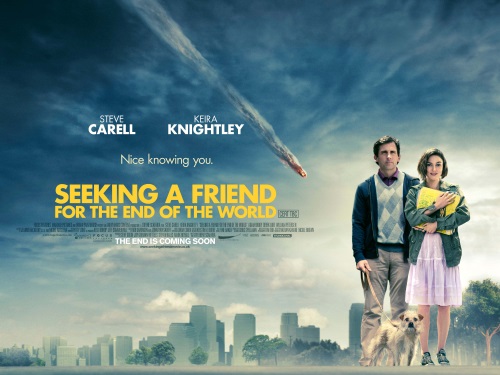
The original logline for this unique post-apocalyptic movie was:
As an asteroid nears Earth, a man finds himself alone after his wife leaves in a panic. He decides to take a road trip to reunite with his high school sweetheart. Accompanying him is a neighbor who inadvertently puts a wrench in his plan.
The small quirky drama version of this story would have a logline that simply read:
A man finds himself alone after his wife leaves in a panic. He decides to take a road trip to reunite with his high school sweetheart. Accompanying him is a neighbor who inadvertently puts a wrench in his plan.
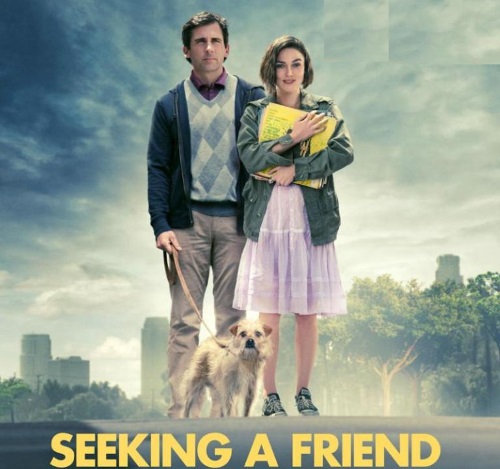
Those could very well be two different movies. The end-of-the-world setting gives an added angle to an otherwise simple story.
Now let's try the reverse of that hybrid. We consider the celebrated indie film Before Sunrise.
The original logline for that film was:
A young man and woman meet on a train in Europe, and wind up spending one evening together in Vienna. Unfortunately, both know that this will probably be their only night together.
An alternative logline when you place them in a genre setting could be:
A young man and woman find themselves as the sole people left behind after The Rapture. They travel to the places they've always wanted to visit as they discuss life and learn why they weren't taken with the rest.

The same, but different.
It's all about looking at your screenplays, the stories, and the characters and asking yourself, "How could I think outside the box and put a unique spin on this story?"
5. Change How You Pitch Your Projects
So not everyone can go out and make high quality trailers, short films, and proof of concept videos. So what's the next alternative that is more accessible to the average screenwriter?
Finding creative ways to stand out is key as you realize that there are thousands of others trying to do the exact same thing that you are. How can you change your query emails? How can you change the way you present your projects in any given situation?
If you read ScreenCraft's How to Sell Your TV Series the Stranger Things Way, you'll see that the Duffer Brothers took a rather unique and creative approach to pitching their series.
They had a love for all things Eighties and they crafted a show set in that era. When they began to develop the pilot, they also conceived a somewhat cryptic show bible that would display the themes, homages, and inspirations behind what they were trying to sell.
“When we were selling it, we made a fake Stephen King paperback cover for the show, [then called Montauk]. We actually used the Firestarter paperback and put our title and an image of a fallen bike on top of it, so when we were trying to come up with titles, we would type them out onto this paperback cover and it would help us. And Stranger Things sort of sounds like Needful Things—it sounded like it could have been a Stephen King book from the ‘80s,” Matt told The Daily Beast.

Why can't screenwriters take a similar approach when pitching their spec scripts? Well, they do. Studios, agents, managers, and producers have been attracted to pitches that use creative elements to sell the concept, setting, tone, and atmosphere of potential scripts.
You can hire graphic designers to create movie posters for your scripts and place them within the body of any query emails you send. If you manage to get meetings with agents, managers, producers, and development executives from cold queries, contest wins, or networking, you can use visual aids to sell your vision of whatever story you've written.
Anything is possible.
Most screenwriters eventually learn that thinking outside the box is a must. The industry is designed to prevent just anyone from getting in. There has to be a filtration process given the number of submissions versus the number of projects and writers that are made and hired. It is the job of the screenwriter to think outside the dictated perimeters — within reason.
The first objective is to write a great script. Once some great scripts are in the system, the cream will often rise and the powers that be will take notice. But because of the amount of screenplays and screenwriters out there, many great scripts slip through the cracks. Sometimes it's because of poor marketing on the screenwriter's end. Sometimes it's bad luck.
Thinking outside the box is necessary to increase your odds of breaking through.
Beyond these five suggestions, there are endless possibilities. Hop on out of that box and find them.

Ken Miyamoto has worked in the film industry for nearly two decades, most notably as a studio liaison for Sony Studios and then as a script reader and story analyst for Sony Pictures.
He has many studio meetings under his belt as a produced screenwriter, meeting with the likes of Sony, Dreamworks, Universal, Disney, Warner Brothers, as well as many production and management companies. He has had a previous development deal with Lionsgate, as well as multiple writing assignments, including the produced miniseries Blackout, starring Anne Heche, Sean Patrick Flanery, Billy Zane, James Brolin, Haylie Duff, Brian Bloom, Eric La Salle, and Bruce Boxleitner. Follow Ken on Twitter @KenMovies
For all the latest ScreenCraft news and updates, follow us on Twitter and Facebook!
Tags
Get Our Screenwriting Newsletter!
Get weekly writing inspiration delivered to your inbox - including industry news, popular articles, and more!

